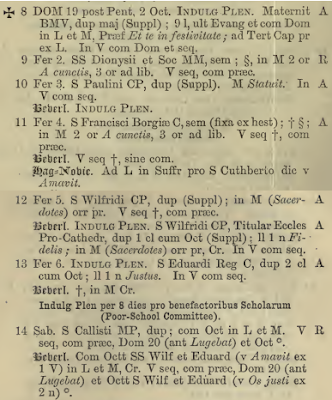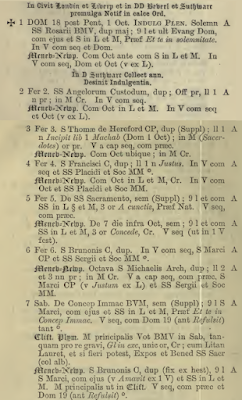Announcement of the Indulgence, the Holyday and the Feast of Devotion
+24 Sunday Fourth Sunday of Advent, second class. Vigil of the Nativity. Mass of the Vigil, commemoration of the Sunday only (after the Gradual, Alleluia and the succeeding verse are said). Last Gospel of St John. Ministers wear violet dalmatic and tunicle and the organ may be played. Violet. First Vespers of Christmas without commemoration. White.
The Indulgence Begins
+25 Monday PLENARY INDULGENCE. The Nativity of or Lord Jesus Christ, double of the first class with Octave. Creed, Preface and proper Communicantes (at first Mass noctem sacratissimam celebrantes; afterwards diem sacratissimam). At second Mass commemoration of St Anastasia Martyr. Last Gospel of the Epiphany at third Mass. At solemn Mass Priest and Ministers genuflect when Et incarnatus est is sung in the Gospel. If a priest says only one Mass then if it celebrated before dawn the first Mass of Christmas should be said, if later, the third. White. (See note below regarding purification and ablutions of a priest saying more than one Mass.)
‡26 Tuesday Feast of Devotion, Mass Pro Populo. St Stephen Protomartyr, double of the second class with Octave. Commemoration of the Octave of the Nativity, Creed, Preface, and Communicantes of Christmas. Red.
‡27 Wednesday Feast of Devotion. St John Apostle and Evangelist, double of the second class with Octave. Commemoration of the Octaves of the Nativity and St Stephen, Creed, Preface, and Communicantes of Christmas. White.
Salford Feast of Devotion. St John Apostle and Evangelist, Titular of the Cathedral, double of the first class with Octave. Commemoration of the Octaves of the Nativity, Creed, Preface, and Communicantes of Christmas. White.
‡28 Thursday Feast of Devotion, Mass Pro Populo. The Holy Innocents Martyrs, double of the second class with Octave. Commemoration of the Octaves of the Nativity and St Stephen and St John, no Gloria, Tract in place of Alleluia, Creed, Preface, and Communicantes of Christmas. Violet.
Salford Commemoration of St John before that of St Stephen.
‡29 Friday Feast of Devotion, Mass Pro Populo. St Thomas of Canterbury Bishop Martyr, Patron of the Secular clergy of England, double of the first class with Octave. Commemoration of the Octave of the Nativity, Creed, Preface, and Communicantes of Christmas. Red.
Westminster, Hexham and Newcastle, Liverpool and Southwark PLENARY INDULGENCE
Northampton Co-Titular of the Cathedral. PLENARY INDULGENCE throught the Octave.
30 Saturday Mass during the Octave of the Nativity, semidouble. Commemoration of St Thomas and of St Stephen and of St John and of the Holy Innocents, Creed, Preface, and Communicantes of Christmas. White.
Salford Today and tomorrow St John is commemorated before St Thomas throughout the diocese.
Announcements of the Feasts of the Circumcision and Epiphany
+31 Sunday in the Octave of the Nativity. St Sylvester Confessor
Pope, double. Commemoration of the Sunday and of the Nativity and of St Thomas
and of St Stephen and of St John and of the Holy Innocents, Creed, Preface, and
Communicantes of Christmas. White.
Benedicite
servi Domini Domino
Note: When a priest celebrates Mass more than once, each
Maas must he said entirely, including the prayers at the foot of the altar. The
only difference to be observed is with regard to the purification of the
chalice. If the celebrant is to say Mass again the same day he may not purify
the chalice in the usual way because to do so would break his fast. At the
Offertory of the first Mass it is better to pour all the contents of the wine
cruet into the chalice. This will prevent him from taking the ablutions afterwards
through oversight. After the consumption of the Precious Blood he replaces the
chalice on the corporal and covers it with the pall, He takes no ablutions; he
says the prayer, Quod ore sumpsimus, with hands joined, at the middle of
the altar; then purifies his fingers in the little glass vessel containing
water, which should stand on the gradine or altar, saying Corpus tuum,
Domine. Then he covers the chalice, unpurified, with the purificator (not
wiping it inside), paten, pall, veil. But he does not put the corporal into the
burse. The chalice remains standing on the corporal, the burse at the side. If
there is an interval between the Masses the unpurified chalice—which must all
the time stand on a corporal—may be left on the altar, or brought to the
sacristy, or even put (without the veil) into the tabernacle. If a solemn Mass
is to follow it may be brought to the credence and placed there on a corporal.
Before veiling the chalice or before the next Mass, or even at the Offertory,
he must put an altar bread, to be consecrated, on the paten. At the next Mass
he does not wipe the chalice inside at the Offertory nor does he then place it
on the altar outside the corporal. He places it a little to the Epistle side
within the corporal and there, raising it slightly, puts in the wine and water.








































































